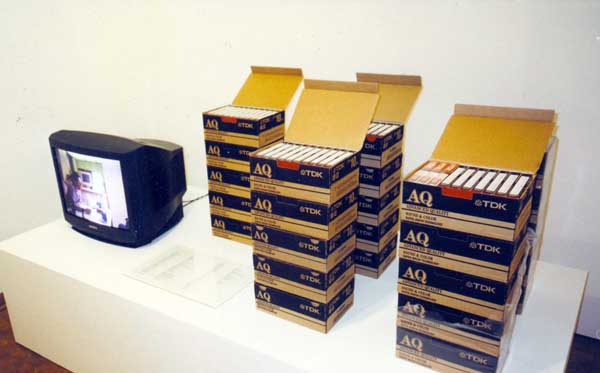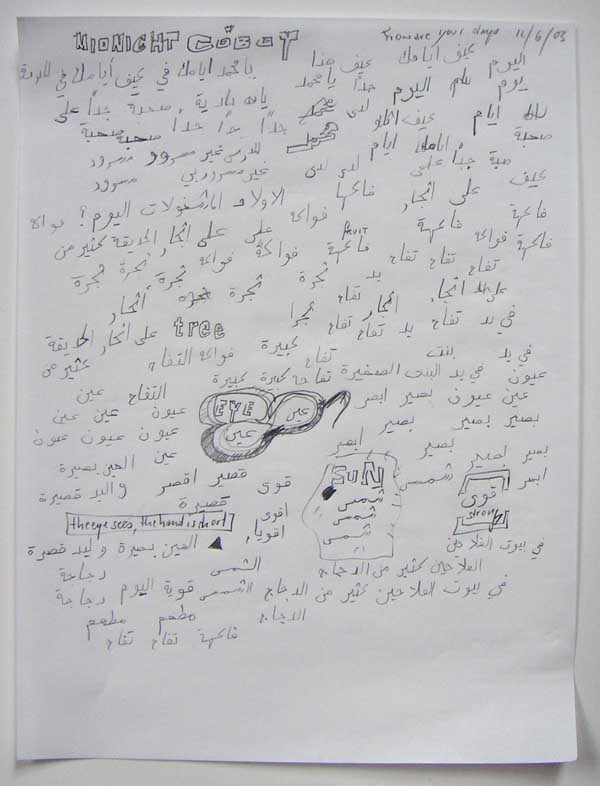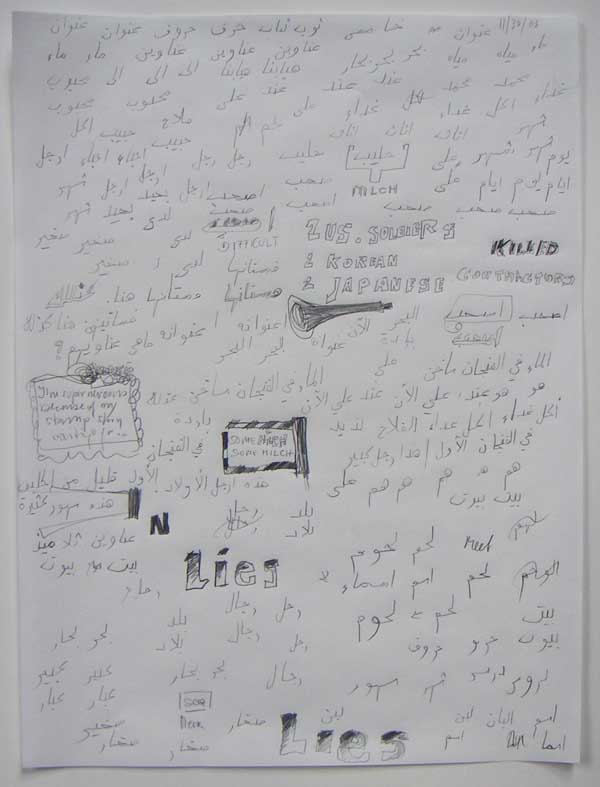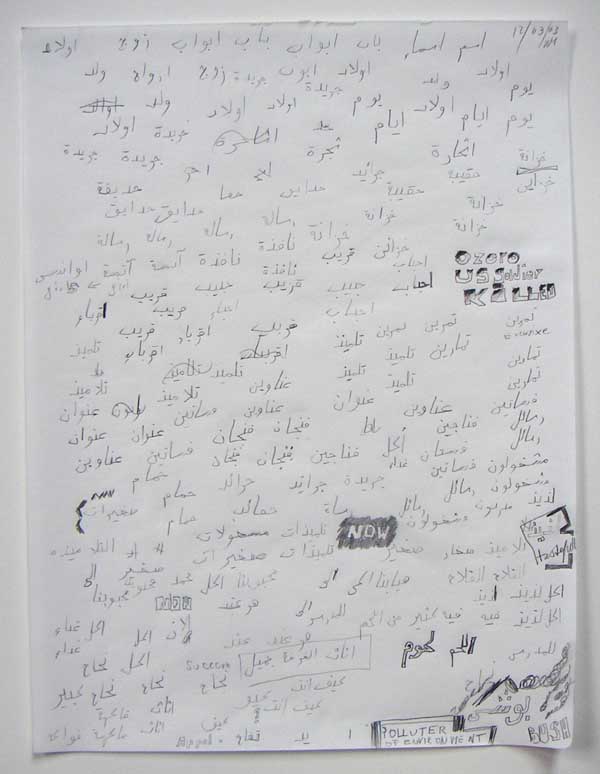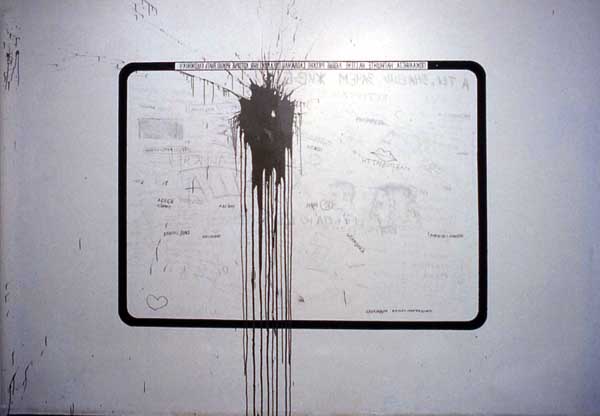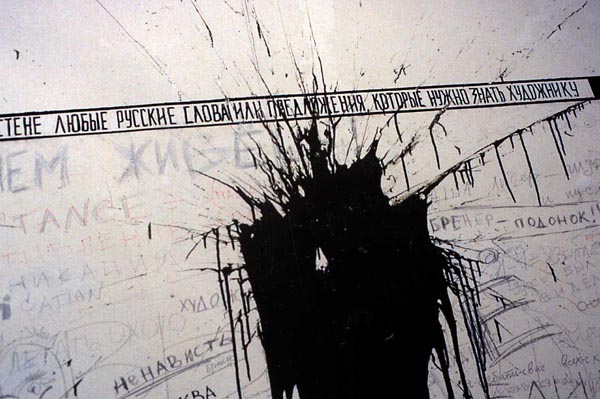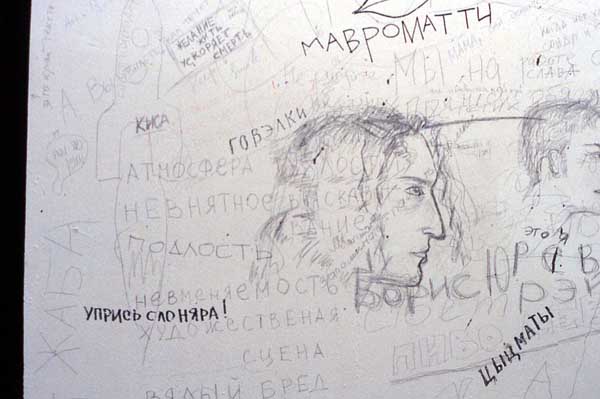When attitudes become - curating.
The 747 was born out of the explosion of the popularity
of air travel in the 1960s. The enormous popularity of the Boeing 707
had revolutionized long distance travel in the world, and had began the
concept of the "global village" made possible by jet revolution.
The first edition of the jet, the 747-100, rolled out of the new Everett
facility on 2 September 1969. (http://en.wikipedia.org/wiki/Boeing_747)
In 1969 Playboy magazine printed an interview with Marshal McLuhan in
entitled "A Candid Conversation with the High Priest of Popcult and
Metaphysician of Media," pp. 53-74, in The Essential McLuhan, Eric
McLuhan and Frank Zingrone (ed.), (New York: Basic Books, 1995)
When attitudes become form, March - April 1969 1969, Suisse, Berne, Kunsthalle,
curator: Harald SZEEMANN.
As a child, an impressive day was when we drove to the airport Zurich. Nobody was dropped off or picked up. We couldn't even imagine flying since we didn't know anybody living beyond 30 minutes driving. We went to see the first jumbo jet, the Boing 747, which left the factory in 1969 and was flying first for PanAm in 1970. On that occasion, we went on to visit a newly built shopping center outside Zurich next to the high way, another novelty in the early 1970s. Our family never entered a museum, nor any bookshop or library.
"When attitudes become form" was an exhibition that wouldn't
have been possible without the jet revolution. Harald Szeemann was working
for Kunsthalle Berne and had traveled the USA where he got to see contemporary
American art. This new art was already made by artists who had started
to travel by airplane and were mobile. This mobility changed not only
society but also art. I believe that conceptual art was the first 747
art form to facture transportation and mobility into material decision-making.
Marshal McLuhan's the-medium-is-the-message conversion soon dominates
all conversations that defined art: language and concept related works
emerged and artists started to communicate. Thought it was Karl Marx who
first discussed machines and tools as extensions of human organs and the
human body, McLuhan reworked it for a happily communicating and mass consuming
"global village" in which everybody potentially conversed with
everybody with no specific regards to relations of production and class.
A new area of national, racial and sexual liberations and emancipations
took off. The birth control pill, live TV-field-broadcasting, portable
and affordable video cameras, early computers and consumer electronics
rendering the world fun and promiscuous before the oil crisis, aids and
terrorism doomed the arena. The Munich 1972 Olympic terror attack coincided
with the beginning of live TV field-journalism broadcasting with mobile
cameras outside TV-studios. Artists and intellectuals also celebrated
this new world. They entered the field with propositions and international
exhibitions independent of museums and galleries. Ausstellungsmacher -
exhibition makers - became welcome and necessary to sort out existing
disorders and create new ones. Harld Szeemann called his office "Büro
für geistige Gastarbeit" - Office for intellectual guest work
- recycling the German term Gastarbeit usually reserved only for the then
new phenomenon of unskilled migrant industrial workers in Western Europe.
Gastarbeiter were and have been (even after generations) perceived as
foreign with only modest help for integration. Capital, work, services
and products traveled and exchanged and art as always tried to keep up
with the pace. Today, curators too are more often then not free agents
not directly associated with an institution. Szeemann himself has been
defining his role as a free agent even though there have been lose but
steady institutional associations. The same is true with many other well
known contemporary curators who might be employed by a museum or a Kunsthalle
but are perceived as independent and ready to be hired for any show anywhere
in the world if the context is attractive - i.e. reputation and remuneration).
Today, the internationalized system of art has become so complex and sophisticated
that any role can be taken on by any player anywhere in the game. We more
and more see now also artists collecting, curating, writing and dealing
as well as collectors, writers and curators making art and reflecting
about artistic production in the role of writers and art historians. Interesting
enough, even Harald Szeemann, and not only Hans-Ulrich Obrist couldn't
resist taking on the role of artists: He showed in the Tirana Biennial
2003, where he had some silk-screens made. Another example of mixing roles
is this text which was commissioned by Victor Misiano, a trained art historian
who turned curator, publisher, critic and director of an art center. ("I
am deputy director of the State Center for Museums and Exhibitions. I
am editing my Moscow Art Magazine. I am curating, publishing. writing
and so on") Misiano commissions me, an artist, to write a text on
how to teach curating. He doesn't ask me for an artwork, he asked me for
a pedagogical essay.
It can't be pointed out enough that these changes are the product of a
dramatically changing society and its permanently improving technologies.
Therefore any other domain changes as well. I give here only three basic
unrelated examples but which artists and curators have come to reflect
upon. Banking: I pay now with money I don't have and make financial transaction
with the computer and the mobile phone. I shift virtual money - a euphemism
for my debts - from credit card to credit cards and feel lured into debts.
I have started to believe that my extending credit frame is my actual
money. Food: I call in for food, or I take it out, I freeze it and microwave
it. I also complement it with highly processed vitamins, proteins and
whatever I think I need that doesn't often resemble anything "eatable"
or "natural". I also cook myself with easy to follow instructions
and pre-prepared substances. Needless to say that parts of my foot is
now manipulated, designed in size, resistance, taste and composition.
I came recently to realize that often in one bite I have products from
three to four different continents. Yet, another basic activity that undergoes
drastic change is work: Today, we work at home, we work in teams via computers
without seeing each other, we work three jobs and more at the same time.
We chose, we outsource and subcontract parts and entire productions and
work in multiple places around the world simultaneously with our digital
arms, voices, eyes and brains.
Is it therefore a surprise that I - in the role of an artist - make my
curators paint my paintings, my dealers do my drawings and part of my
artistic decision-making. Here at home, I study Chinese and Arabic, I
write texts, I try to sell my art, and I panic to organize money, recuperate
debts from others, curate shows, advice dealers. I even collect some art.
Currently, there are up to 20 people producing my artistic work for me
in different places, different continents for different shows with different
financial support. It is partially done by people who are no artists and
don't understand it. If my computer is an interface, I am an "interbrain,"
a decision-making body which is processing and producing information.
In this new, twisted and multi-layered international context, curators
have to create and not only find their own niche. They have to work locally
as well as internationally. Some local positioning comes almost automatically
with international exposure. Getting a show or curating a show even in
upcoming Brooklyn galleries - so let's even ignore Chelsea or London's
East End - will be noticed in mayor art centers around the globe with
the speed of spam. On the other hand, any international exposure today
is barely reaching a larger audience then any traditional local community
since the grandiose art world of today is thinned out to a tiny suburb
in a village. A minority of highly specialized professionals that communicates
across borders in a new audio-visual Latin backed by a fast changing theoretical
jargon starts to vitally interact from the moment new members enter graduate
classes in fancy international art schools. Art-star teachers, often not
longer out of school then their students in school, integrate quickly
new artists into a tide network of contacts. They smoothly mingle with
curators, and writers in the many international events available, first
as volunteers and interns, then as curators and artists. Many public event
providers who love to act internationally offer now "residential
programs," and indoor or outdoor experiments for curating and art
making. European countries see in their cultural spheres national and
chauvinistic pride without ignoring the fact that museums and cultural
activities are promotional keynotes for their local tourist industries
as well as for their real estate sectors. This allows for a very active
exchange between all cultural participants on an international level.
Grants are the passwords for this international exposure.
Recently, curating has not only become internationalized but also institutionalized
and turned into a discipline that is taught academically. International
classes for curatorial learning are now created anywhere: at universities,
art schools, museums, auction houses and so on. The question of "What
to teach curators?" is about as impossible to answer as "What
to teach artists?" in a time of deskilling and artistic outsourcing.
I am convinced that the recipe for a good curator is the same as for somebody
who succeeds in life and anywhere else. It is an elixir that I locate
in people themselves. It is the basic understanding of who we are, of
where we are from, of how we are living, of what we want, and of what
we can do. This "che voi?" (Italian: "What do you want?"
Lacan) is crucial in shielding us from things other people want us to
want, to do, to buy, to believe, to sell, to say and to fight for. Concerning
art and artist, I don't really have any preference as long as I can see
that there is a genuine interest in what a person is doing, an interest
that is not opportunistic, externally driven and remote controlled by
trends and dominating taste formations. Curators too, should learn to
distinguish between motivations and interests that are intrinsic and logical
to those that are not. On top of that they have to figure out what kind
of art they would like to defend, for whom, and why. They also have to
find inventive ways to put their vision respectfully into practice without
the total exploitation of artist and anybody else helping in the making
of a show.
Everybody should have answers to the questions of why they do what they
do. These answers should be intrinsic to the job and not extrinsic to
it. Money, power, and banking love shouldn't dominate curatorial or artistic
decision making though it can never be avoided. But we all know people
who are purely motivated by the social context onto which they project
themselves without any authentic interest in what they do. Many are those
curators who only work with the view artists from high-powered galleries
with already guaranteed status. This reinforces the given artistic and
curatorial status quo without challenging it - sometimes without even
comprehending it. Curators should not only understand artists, be able
to listen to them but should also understand their own role in today's
constant remaking of a complex cultural and political landscape. Anything
we visitors, collectors, curators, artists, and dealers do is part of
on an ongoing eternal shaping and reshaping of esthetic, cultural and
intellectual standards that have wider political, social and ideological
impacts. Cultural and intellectual formations can be liberating or oppressive
and have wide repercussions on individual psychologies but also on general
politics. Right now, in the post-9/11 period in the United States, cultural
institutions and universities are under more pressure to be complicit
with right wing politics and encourage a terrifying culture of mutual
mistrust and eavesdropping. Critical departments lose their funding, political
speech is discouraged and intimidated, artists are threatened with lawsuits,
and independent media outlets risk being silenced. It has been so far
impossible for a group that resisted the war against Iraq to purchase
advertising space at Time Square denouncing war. Currently there are several
lawsuits opened against artists and I could be one of them given "my"
US-postal stamp-project that plays with symbolic civil disobedience (www.ganahl.info/cuchifritos.html).
Today, everybody has to understand that he/she is part of a larger discourse
shaping our public and private spheres in a less oppressive way.
Years ago, I happened to be part of the Whitney Museum Independent Study
Program (ISP) that puts artists, curators and writers together in a course
for professionals expected to succeed somehow in the highly competitive
field of cultural production. During that formational year, we worked
together without much discussing art and the usual politics that surrounds
it. Art seemed almost a taboo that was better addressed in the back rooms
and corridors than in the regular and frequent plenum discussions. We
were expected to read books, and had to work through non-ending photocopies
of articles relevant to discussion on the cultural front. Art was only
one optical device to look outside our windows. In many ways, it did change
my way of thinking and doing things, for not saying that it actually changed
the direction of my life. This wasn't the case because of social contacts
made during that program but because of what we discussed, what we read,
what we focused on. I found subsequently a way to reformulate my art making
and thinking that can be partially traced back to the two years I spent
there. A couple of years later, I was invited to Grenoble where a curatorial
"école" was created. When the ICP program didn't provide
any means and was only equipped with a photocopy machine, the Le Magasin
in France offered grants, travel stipends and all kind of other possibilities
still unavailable to the NY based program. To my surprise, in France,
nobody was interested in art or any subject I proposed to discuss. The
talk was only about "How did you get your book published," "How
do you get in there" etc. Traveling and social networking were privileged
over reading and discussing culturally important issues.
Lets now look at the question of power for some of these relevant cultural
agents. As I have pointed out earlier, cultural roles are becoming more
diversified, more difficult to define and somehow interchangeable in this
always changing landscape. Yet, this doesn't indicate that the power and
influence inherent to these roles is evaporating. If artists curate a
show or collect art they create the same effects on the distribution of
power and influence than when "curators-only" or "collectors-only"
do it. As an artist, I have had quite some troubling experiences with
artist-curators. Some of them have assumed the power of curators but not
the responsibilities of curating. During the selection process they were
reasoning like curators but during the organizational phase they acted
like artists: i.e. paying little respect to artist's work. Artists have
the right to see the world through their works and are allowed to deal
with their art works in whatever way they decide. But when in the role
of a curator, they have to change their optics and need to respect other
artist and their works. Of course, people who are professional curators-only
can act irresponsibly as well.I am going now to be very specific and polemical
and use samples of my own experience, positive and negative ones. I might
risk consternation on both ends: There are many curators I have had the
pleasure and honor to work with excellent and positive outcomes then I
can list here. Also, generally speaking, I have been treated by most curators
with respect, intelligence and generosity. Of course, the experiences
on the other end of the spectrum have been disappointing but relatively
minimal. Pointing to a few cases where things went wrong might add a bitter
taste to this essay when reading it. But it hasn't disenchanted me: Quite
the opposite. I have learned to understand that behind these conflicts
- that can take on very personal and idiosyncratic forms - there are mostly
structural problems traceable back to weak financial support due to greedy
communities that host these institutions. For the few negative cases I
have created web-pages that feature the exact development and context,
and show key correspondences.
My worst experience ever so far has been with Italian curator Claudia
Zanfi who has been trying to disown me of an artwork of mine using quite
intricate tactics to do so. We are still in dispute since my piece has
not been returned. This case is documented to the point that is almost
amounts to a sociological study of a town (www.ganahl.info/sassuolo_txt.html)
and serves as an example of an entire network of exploitation and self-exploitation
in the middle of a rich city that refuses to give enough money to the
arts in spite of its attempt to recycle it for its image. The curator
Zanfi made herself a complicit agent in this mechanism of disrespect and
abuse. Maike Pollack from Southfirst gallery in Brooklyn is another case
of somebody who tried to extort artworks from me and even kicked me out
of the running group show I was in (www.ganahl.info/stamped.html). Ad
midst some minor cases of frustrations which I'm listening here in the
hope of pressuring some solutions thanks to the power of free speech,
I have to mention well-known Italian artist Maurizio Mnannunci who heads
a respected art space in Florence entitled BASE. After three years of
empty promises, he still hasn't yet reimbursed me the promised airfare
nor returned my art works. The other petty case that isn't even worth
a description here can be seen on line with some artists-curators based
in Amsterdam (www.ganahl.info/arti.html) who did me in financially and
on the level of presentation. My last remarkably disappointing example
in curating with a large and respected institution had been with Christian
Bernard who invited me to do a one-person show in a part of the Mamco
in Geneva in 1997. Though funding was guaranteed and a time for the opening
was chosen, the show was abruptly canceled for rather ludicrous reasons
only 2 months before its scheduled opening. No rescheduling. In place
of my show, Bernard put the work of an artist who much more smoothly fit
the social network context of the rest of the artists then occupying his
chic museum. In that case, it wasn't money or financial support that provoked
the conflict though Bernard used the funding-argument as a pretext. He
had my written assurance that all costs were covered by resources others
than his.
Before I go into positive territory of my best experiences with curators
and museum programmers, I would like to address the funding issue, a permanent
source of potential conflict. There are artists who reject participation
when there is no funding, when they have to pay themselves. I do not share
this position and differentiate. I sometimes participate even when I have
to pay myself. But I have learned to insist that funding is discussed
in a clear and comprehensive way upfront. Years ago, I accepted the no-funding
conditions of the Contemporary Art Center Moscow when Victor Misiano was
curator. At that time there was no money in Moscow and Misiano made it
clear from the beginning. I organized myself, went ahead and had a great
time. I was able to produce a show I organized around the studies of Basic
Russian and my Reading Seminar projects. This exhibition has been important
for my own working-history and the lack of international reception and
funding didn't matter.
Currently, I'm working on a one-person exhibition for a non-for profit
space in Hong Kong, Artist Commune, which requires elaborate work. The
chief curator Shin-Yi Yang, who is currently in a PHD-program at an Ivey
League school here in the USA, invites a guest curator, Mie Iwasuki who
invites me. The show sounds great but there is also no funding. He simply
seems to ignore the fact that we are on the other side of the globe. It
was made clear that there is no money. I accept it because several volunteers,
including both curators will study with me Chinese on a regular basis
advancing my four-year old Basic Chinese art project. Mie Iwasuki is hard
working and supportive. Additional to teaching Chinese, she is painting
three large canvases for my show. I will pay my own flight ticket, cover
the costs of most of the materials and hope to have a nice time in Hongkong.
Without making it look like a complaint I can't ignore the fundamental
question why a rich city like Hong Kong can't afford basic coverage of
artistic activities? Why do curators work when there is no financial support
for the arts? Answers are complex but always comprehensive within the
logic of pre-monetary thinking that dominates the art world. My "I
don't sell but I learn something"-mantra undergoes in this case a
slight modification.Currently, I am in another international situation
with no funding that is acceptable and pleasant. It is an intelligent
show that doesn't require any money. They understand that internationalism
doesn't necessarily have to signify air travel and jet lag. Alejandro
Cesarco and Gabriela Forcadell are curating a show - if we are allowed
to call it that - for the Centro Cultural Rojas without any significant
funds but lots of engagement, ideas and pleasure. At least, Cesarco is
living permanently in Brooklyn and acts as a satellite decision maker
to the Argentineans, still hard hit by the failed politics of the IMF
and the World Bank. I am one of the artists invited every month to present
a bibliography to read with an introduction explaining the artist's selection
of texts with proposed reading strategies. The texts go into an archive
they are about to set up in remote and cash poor Argentina. There seem
to be lots of people left with curiosity and interest for art and artists'
reasoning. For me, this participation is not only a perfect pretext for
reading but also a way to brush up the link between my fingers and some
parts of my cortex. I love to express myself with old-fashioned media
that have been dominating me and my artistic rendering: reading, writing
and discussions have been the center pieces in many of my exhibitions.
These basic cultural practices have become more and more anachronistic
in a cultural status quo that works with mice, scrolling bars, clicks
and remote control sticks. Seeing these curators - who are mainly artists
who don't like to wait around - working respectfully with simple and eco-friendly
strategies makes me almost forget about the stress that can define this
world of programming.
Next to money, there are many other conflicts like we know them in daily
life. I am going to pick here only a few that become more and more apparent
between curators and artists: Artistic interference by curators. It is
the result of changing roles and the deskilling in many artistic practices.
Curators start to interfere and compete with artists in the artistic decision
making process: "Make it bigger, make it smaller, use this material
etc...." Curators also assume roles that resemble prior demands by
Maecenas and other patrons. "We want you to do a bar, a dance floor,
a skateboard ramp, wall paper, furniture, a floating structure, and last
but not least a tomb for the CEO." The merging of artistic production
with the emergence of a small artistic cottage industry of social services
reinforces this kind of interference as well. "Could you a reading
seminar? Will you teach the children of the neighborhood? Will you psychoanalyze
members from our museum board?" Because artists are today often producers
and organizers of their own art works and don't shy away from spectacle
and event planning, their modes of working and managing affairs have become
similar, if not the same to those of curators or dealers. This proximity
between curators and artists is therefore a lure that everybody should
be aware of.
The importance of ("I wonna get mass-") media attention in the
art world is yet another factor that can push artists and curators onto
crashing courses. People compete for public and narcissistic love. Attention
seems to be the lifeblood for our media driven industry. It is not uncommon
that curators of mega-shows are more important than the art temporarily
left behind by an international jet set. When Harald Szeemann invited
me for the Kwangju Biennial in 1997, the Korean press couldn't stop asking
questions about my star curator. "How is it working with him? How
did he find you? Have you worked with him before? What do you think about
Szeemann? Etc..." Almost no substantial question about my artistic
proposition was asked. Today, many writers follow this obsession with
curating and curators. Larger group shows don't seem to fall or stand
with the work of the artists in the show but with the curatorial reasoning
placing it. Unfortunately, this selection process can often resemble horse
betting or stock picking contests. People prefer seeing reoccurring high
profile names mixed with unknown young newcomers. Older artists try to
rejuvenate themselves through collaborations with young talents. Curators
reinvent themselves by inviting younger artists. They easily can change
their modes of working and synchronize their perception with the flux
of things.
It is no surprise that thinking about art in scores and ranking proliferates
since even investment capital enters the arena. Without knowing many details,
it came to my attention that some high profile US-curators are not only
advisors but founders of a venture fund amassing capital to invest in
the arts. With auction prizes of contemporary art exceeding even the appreciations
of internet-stocks during the frantic years of irrational exuberance,
it is no surprise that institutionalized investment thinking has become
a reality. By the way, published best selling lists in business magazines
of artists have been around since the 1980s. I sometimes have the feeling
that many curators of museums make exhibitions to impress and signal to
other curators and directors of museums advised by blue chip galleries
and collecting board members. The "shopping" of artists is defining
museum profiles. At the peak of their careers, highly overbooked and overexposed
players move from big museum to big museum only. It is not an easy game
to assure the booking of these high-flying artists. This gives the false
impression that there is such a think like the NBA of art.
But there isn't. More often then not, when artists touch a certain critical
point of success and exposure they start to over-produce and under-perform.
I am inclined to say that museum shows that don't challenge artists, curators,
the public and critics are prerecorded visual musak. We all shouldn't
ignore the common fact that most artists become known for works they did
when few people expressed interest in them and when barely anybody was
spending money on them. In this landscape of illusions, endless diversity
and competitive selecting, decision-making is difficult and contextualizes
curators quickly. "Who do you show? Who do you collect?" Curators
stay and fall with their artists, their galleries, their openings, their
dinner invitations, and their press coverage. Working with famous artists
brings fame to curating (and vice-versa).
I finally resume with the giving of names of people who have offered me
opportunities for one-person shows at moments when the discrepancy between
my recognition as an artist and the importance of the inviting institution
was huge. At the time of my invitation, these curators were in positions
of power and could have shown artists who commanded much higher social
consensus and approval rates than I did. Risking to disappoint important
curators and supporters of mine who for simply technical reasons can't
be mentioned all, I am thanking here the following people who all gave
me one person museum shows: Annegreth Nill, Dallas Museum of Art, 1992;
Timothy Blum, Person's Weekend Museum, Tokyo, 1993; Sabine Breitwieser,
Generali Foundation, Vienna, 1997; Edelbert Köb, Kunsthaus Bregenz,
1998; Each of these curators and directors had open and endless options
for their programming but were choosing me because of my artistic work
only. None of these choices were influenced by social dynamics and networking
power games. There had been no dealer or other match-maker involved. My
status as a relatively unknown artist allowed me to take each of these
shows very seriously. For these museums, I was able to make shows that
have become important for my own art making. Each show has somehow altered
my artistic direction and turned into a crucial corner stone for the developing
of my artwork. Interesting enough, almost all of these shows were relatively
ignored by critics, by other institutions and by collectors. I just received
an invitation by Bill Kaizen to make a one-person show at Wallach Gallery,
the Columbia University Museum in 2005. This is a well-funded institution
that usually limits itself to historical positions only. Again, I am amazed
that this curator and doctorate student in art history has made me his
choice diverting from the regularly prescribed path of his respected institution.
I'm concluding this essay with the banality of stating that there is no
formula to teach neither artists nor curators. Every success story differs
and cannot be replicated or even fully understood. To a certain degree,
it is nearly impossible to decide what success means for people involved:
Busy schedules? Frequent Flier Gold Memberships? Sales? Visitors? Prestigious
institutions? Media coverage? Artistic consistency? For my part, I define
successful stories those that require redefinitions of the very notion
of success. My heart is with curators who sometimes against all odds are
dedicated to a certain artists, or certain aesthetics without landing
social or critical success. I don't even have to like them very much.
In New York, Kenny Schachter has been one of these cases for a long time
that are difficult to define. Next to a curator he is also a lawyer, a
collector, an artist, a writer, a dealer, a gallery owner and recently
a real estate developer. Many of the artists that have come to be meaningful
and recognized in the 1990s had been first showing in Schachter's rather
chaotic events that were placed in unconventional spaces. His frequent
programming was held in empty non-art spaces across downtown Manhattan
were shows were as much visited as criticized. Most of his artists really
hadn't shown before. But quite a number of them moved on with desirable
and profitable careers, some ignoring Schachter in their biographies.
I liked only a handful of artists he had worked with over the years. I
couldn't appreciate the majority of his aesthetics choices, but I very
much recognize and adore the fact that he has been home to many artists
he showed and collected early on, anticipating and shaping major visual
trends in New York. For my personal understanding, Schaechter redefined
and extended the social role of the artist/curator/writer/collector/dealer/entrepreneur
in a way to remember and to shock.
I end abruptly with the unsatisfying feeling that much had been left out.
Being exposed to art and artists is an endless school that is in no need
for teachers or students. Listening to artists should be the most urgent
job of anybody who works or pretends to work for the arts. Good artists
and good curators find their own way to defy the dull institutionalization
and the non-stop commercialization of art and its vital channels of communication.
They are not satisfied with art schools or curatorial training courses,
with dealers and museum directors, with the market and state sponsored
event cultures for chauvinistic or group-narcissistic ends. The same applies
also to an intelligent audience and outstanding collectors who appreciate
and dedicate themselves to things they really like themselves. All these
participants know that they need art in their struggle to live a decent
and meaning full life. In today's international world of total marketing,
spam comes also in form of cultural products we don't want, don't need,
and don't (want to) understand. Today, the responsibility of everybody
involved with the endless process of a cultural and artistic production
and mediation is bigger then ever before. It is a sublime endgame to be
endlessly continued on a glocal level. In order to return to the beginning
of this essay I would like to point out that Fedex, e-mail and the internet
have made even jet-traveling non-essential for being active on the narrow
broadband of a temporal globalizing presence. Since everything seems just
a keyboard away the choices of staying or flying, curating or art making,
consuming or ignoring cultures become not more than an attitude in non-ending
changing world.
Rainer Ganahl New York , July 2004
(unedited text)
PS1: PS1-Moma is amidst many other things not only a sold out program
for artists - it basically is now history since the 12 months program
is cut down to a meaningless three months period that will only produce
"paid exhibitions" (I was told by current participants that
contributing countries are asked to pay 30.000 dollar for 3 months) -
but also a sweatshop for curators and its dancing public in Brooklyn.
I feel like I didn't point out enough that responsibilities in curatorial
decision-making are very important and shouldn't be exported beyond political
thinking. I really feel that if we are not careful enough we risk waking
up on a page of George Orwell with the only difference of wearing better
clothes and seeing in four colors. We might be asked to take off our shoes
not only before boarding a plane but also when "turning corners"
in our cities.
PS2: A careful critical reader/friend of this text has correctly pointed
out that sketches about the "post-Marxist" classless global
village have not been taken up again. He is right. If I look at the provenience
of the most successful recruitments of the “cultured class”
in the USA (Europe will see more of that as well), one cannot ignore the
fact that the politics of private schooling and universities is paying
well off. Successful curators, artists or writers are more and more an
exception and a thing of the past. That is in particular also true with
the very slow but yet happening integration of so-called minorities. They
might be African-American or immigrants of Pakistani, Latino or Chinese
decent but they most likely come from rather wealthy families. Structural
economic divisions on the consuming end of highbrow culture – independent
of whether artworks address popular audiences or speak with the vernacular
of popular culture – are even more determining. The trend to even
facture cultural production as well as consumption into the demarcation
line of class divisions is increasing and can be observed everywhere,
from advertising to real estate planning, from educational investments
to on line dating. Curators should be very much aware of what they are
doing in regard to the accelerating discrepancies within the disappearing
middle classes.
PS3: It goes without saying that I am deeply indebted to and appreciative
of everybody who has worked with me in whatever role. I feel very sorry
that this text does not allow me to name every single person. My text
would have been 20 more pages long. But I do want to mention two people
here in New York who have been and are still tremendously supportive and
generous with me: Devon Dikeou, artist, writer, curator, collector and
editor of zingmagazine and Manfred Baumgartner who is offering me a third
one person exhibition in New York where the killing cost structure is
so high that an exhibition with an artist of my commercial track record
doesn't look justifiable - another curatorial choice against the grain.
PS4: I did not elaborate on the disputes that still are driggering on thought people keep promsing to return works and to pay - the reality until this date has been different and still frustrating. But I do offer links with most of the communications where I clearlyl layout the dispute that is for everybody nothing but a headache. I therefore ask anybody to look at these web pages in case somebody is interested in details. I ommitted these details because it is not the topic of this text.
BELOW some IMAGE choices for possible ILLUSTRATION:
HI RES IMAGES FORf Reading Seminars : IMPORTED -- 1993 - 97
HI RES IMAGE FOR READING FRANTZ FANON
HI RES IMAGES FOR READING GRAMSCI
My First 500 Hours Basic Chinese, 1999- 2001 (Museum Ludwig, Cologne)
250 video tapes of 120 min in 50 boxes, 500 video
click image to download hi res image
Basic Arabic (Study Sheet), 12/6/03 New York
(work on paper, 9 x 12 inches)
click image to download hi res image
Basic Arabic (Study Sheet), 11/30/03 New York
(work on paper, 9 x 12 inches)
click image to download hi res image
Basic Arabic (Study Sheet), 12/03/03 New York
(work on paper, 9 x 12 inches)
click image to download hi res image
click image to download hi res image
Rainer Ganahl
Please, write down the Russian words the artist should should know,1995
interactive wall painting with different responses in different media.
This work was part of my show at the Contemporary Art Center Moscow in 1995. At that time of the shows, I offered this conceptual piece for free to Joseph Backstein (director of the Institute of Contemporary Art in Moscow). Backstein was about to put together a collection of contemporary art in Russia he simply refused my offer. I was surprised since I offered it for free. Backstein, a writer, curator, collector, philosopher and empressario of cultural events diidn't want it. Since it was a piece that could be stored in form of a photograph, a reconstruction diagram and a certificate of authenticity I was really wondering. Today, I am not offering it anymore for free. Since this is the first publication of this piece I would like to thank everybody who contributed to this dialogical work with their writing - and their paint throwing.
click image to download hi res image
click image to download hi res image
more picutres coming soon
